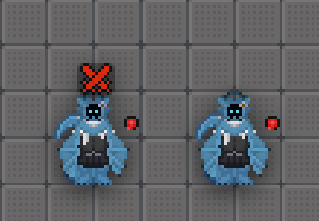Основы КИ
Основы КИ
Это Краткая версия, расширенную читайте ниже:
^ Это ^ Комбат индикатор (CI):
После активации КИ(CI) необходимо подождать минимум четыре секунды, прежде чем совершать атаку, если другая сторона не активирует свой КИ(CI). Если все же она активирует КИ(CI), то вы должны дать ей около двух секунд на реакцию до атаки.
Важные замечания:
- Если кто-то из игроков уже вовлечен в активные механики (например, уже сражается или убегает), необходимости ждать задержку КИ нет, хотя активация Комбат индикатора (CI) остается обязательной.
- Нельзя активировать КИ(CI) заранее или продолжать ролевую игру после их активации.
- Вызвать подкрепление или иным образом втянуть больше людей, это уже считается использованием механик. То есть вас могут атаковать.
- Старайтесь деэскалировать в ролевую игру после завершения активной механики(драка, побег и т. д.).
- Стремитесь правдоподобно обострить ситуации перед переходом к механикам.
- Не выводите игроков из раунда без необходимости и особенно если они не установили на это Opt-in(ссылка с якорем) статус.
- Для антагонистов в пермамехническом состоянии не требуется КИ(CI) хотя активация Комбат индикатора (CI) остается: желательной. Подробнее вы можете почитать тут(ссылка с якорем на политику антагонистов).
1. Combat Indicator
^ This ^ is what the combat indicator looks like.
- Combat indicators signal the transitioning from roleplay to the start of 'combat.'
- Think of it as a handshake that should be returned by the other party, so that people cannot get the jump on someone who is typing, and or not paying attention.
- You should, after activating CI wait a minimum of four seconds if they don't CI back, or, if they do, give them around two seconds post CI, before attacking from the point both of your CI's are active. This applies to everyone involved, equally.
- If the other person is still roleplaying, and the situation and or escalation permits, you can attack once the four seconds pass, even if they don't CI back.
Important Notes:
- If you or your target is in the middle of active mechanics, (already fighting, running away, trying to break/get into somewhere, or away, etc.), you do not have to wait the grace period, although you should still turn on the combat indicator.
- You must wait the required grace period or until the other party has their combat indicator turned on. Turning on combat indicators and attacking immediately is still breaking the rules.
- Do not preload combat indicators, or continue roleplaying after turning them on. Use it or lose it.
Example Scenarios
Remember - Combat Indicator or CI must be turned on first before the grace period timer begins.
- If either party is in roleplay, you should always attempt to roleplay the escalation first, if they try to disengage from the roleplay(start hacking the door to get out, get a weapon out without an emote doing so, etc) you're free to attack as they have actively started mechanics.
- If something is forcing mechanics, i.e. another player, an event like depressurization, and so forth, you are free to engage in mechanics. Though you should still CI.
2. When to Role-play, When to Mechanic
If you are in a roleplay, you should assume roleplay, i.e. saying and emoting, by default, until roleplay dictates that mechanics are needed to advance a scene or if mechanics.
If you intend to call for backup, or else-wise, drag more people into an escalating situation, it will be considered mechanics for application of CI.
Keep in mind that mechanics serve the overarching story and the roleplay contained within, not the other way around. Mechanics are here to make the roleplaying experience more real, not prohibit it from happening.
3. Conduct During Ongoing Scene
If a roleplaying scene is present, you should try to believably escalate the situation, before starting mechanics.
4. React and De-escalate
React to mechanics by mechanics, i.e. individual is running away, however, look to de-escalate to roleplay when able, after 'mechanics' (the fight, w/e) has concluded.
5. No Unnecessary Round Removal.
Do not unnecessarily take someone out of the round. There are no mechanical advantages for round removal. When a player gets killed and then revived, they are not allowed to remember their attackers or how they were attacked.
6. Cooperation
Why do we have all this? Well, at the end of the day, roleplay is a cooperative affair. It is not competitive where you are looking to create an edge for yourself. Rather, it is a community affair where you work together to craft stories for yourself and the group at large.
Equally, you should make use of LOOC to make intents clear when able, in unclear situations (someone about to shoot someone else in the back, mid conversation.) so everyone is on the same page about how a situation is escalating.
Вернуться на страницу политики
Очень черновой вариант (в процессе мозгового штурма)
Как в идеале должен работать КИ? Использовать как эскалацию, значит то что с её помощью показать наши намеренья, при этом с возможностью в любой момент деэскалировать ситуацию. То есть после пожатия КИ вы можете продолжать РП? Переусложняю. По сути КИ нужно, чтобы уровнять шансы, чтобы не ловили на сейлоги и т.п. Тяжело.... Для лучшего опыта для всех игроков, КИ хорошо справляется, позволяя всем сторонам успеть сделать то что они хотели, сказать, показать эмоцию, отыграть сценку. Да он усложняет и создает надстройки для антагонистов, и игроков, растягивает немного боевку, но с другой стороны он устраняет те проблемы которые следуют из-за особенностей игры.
